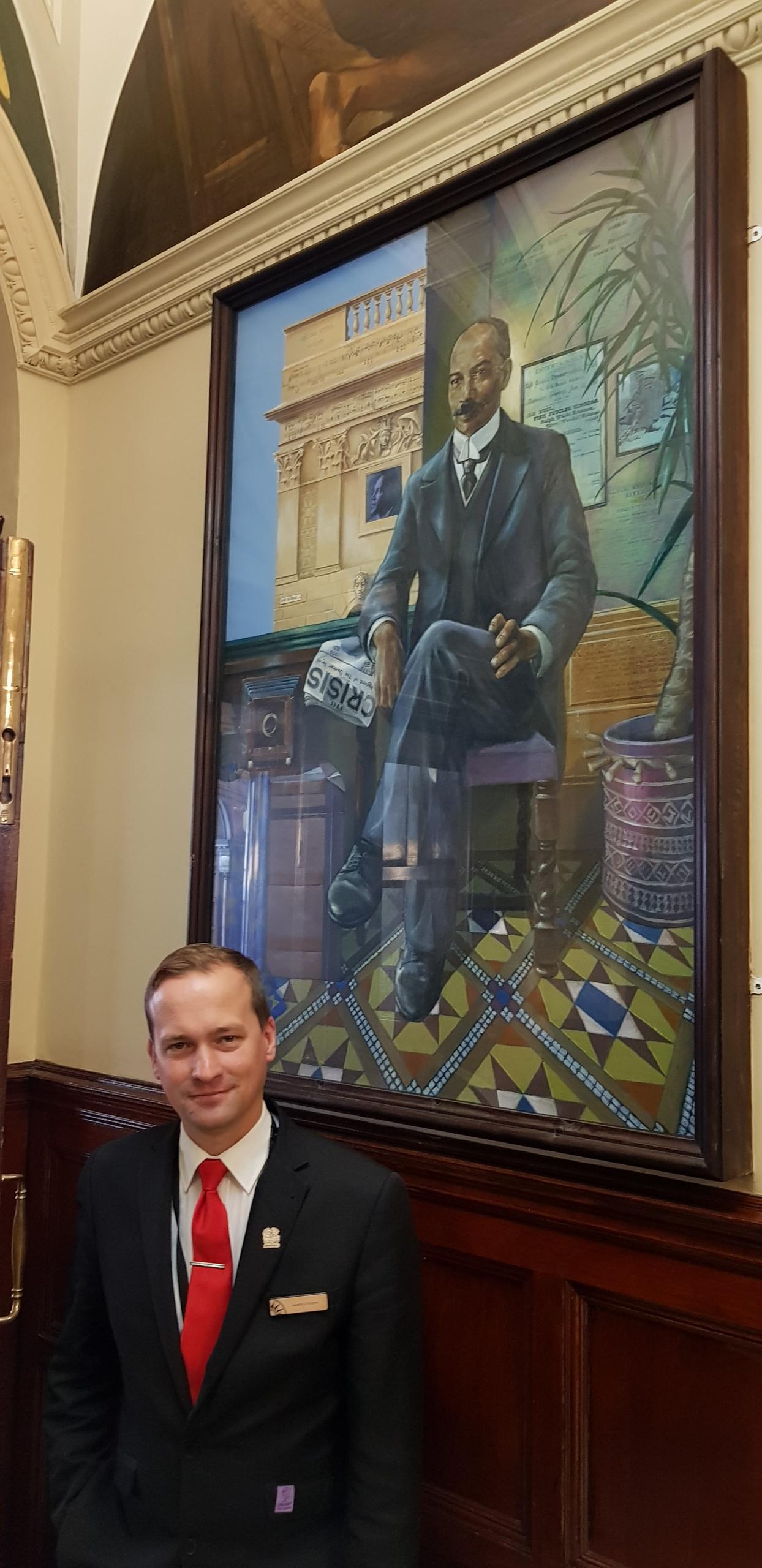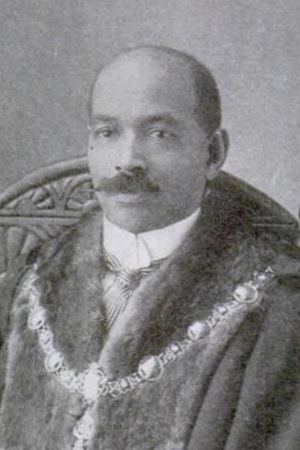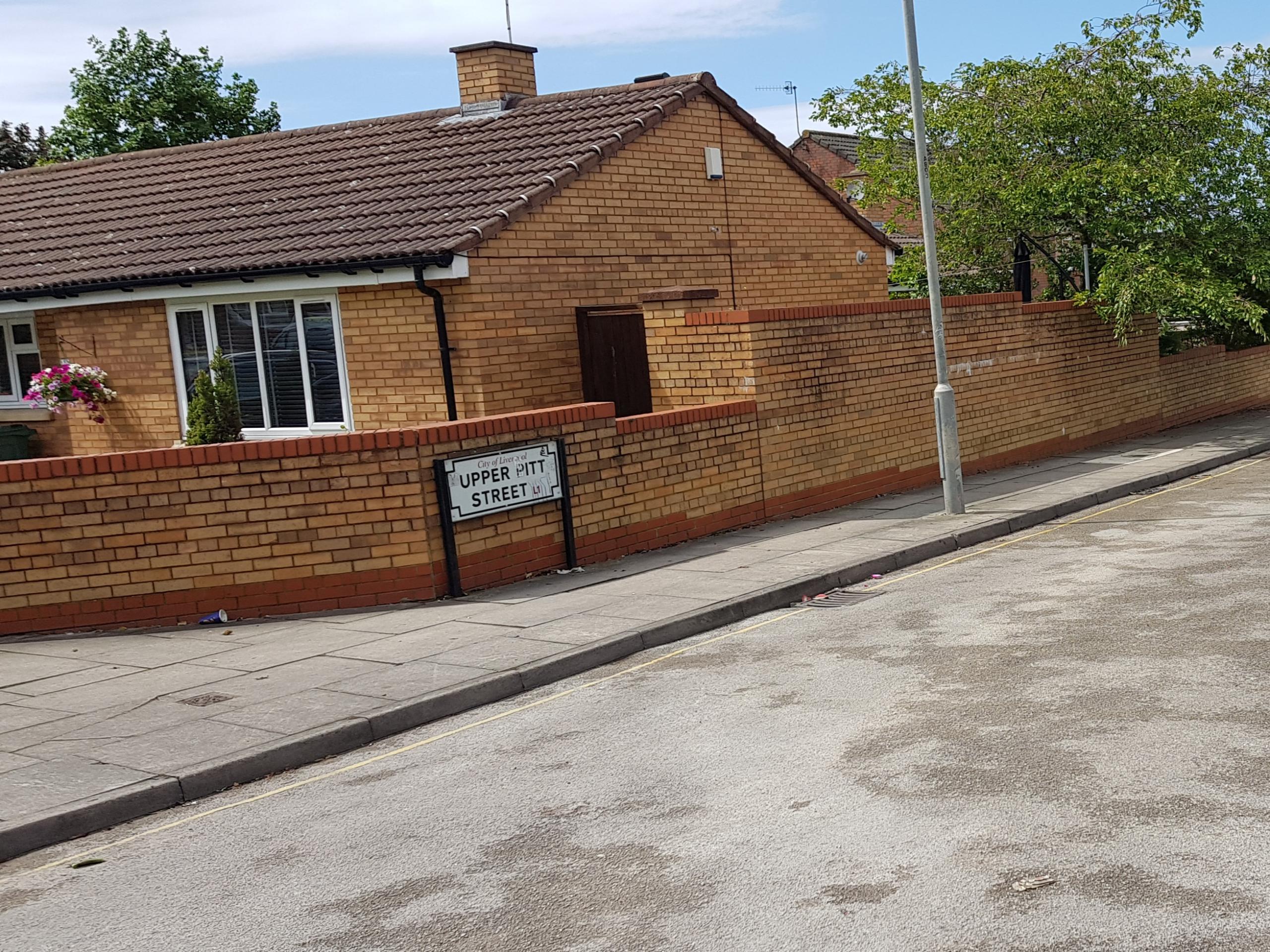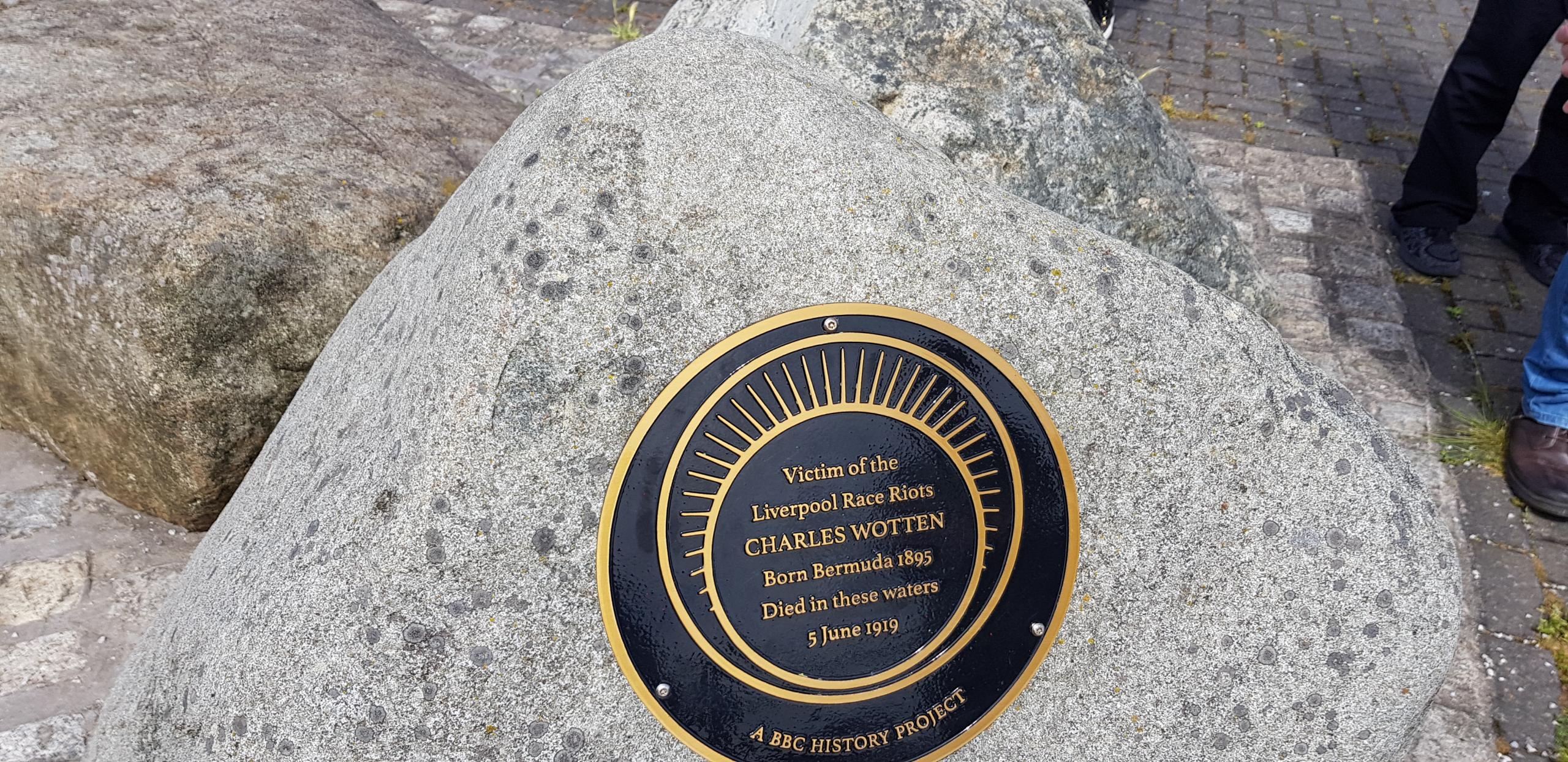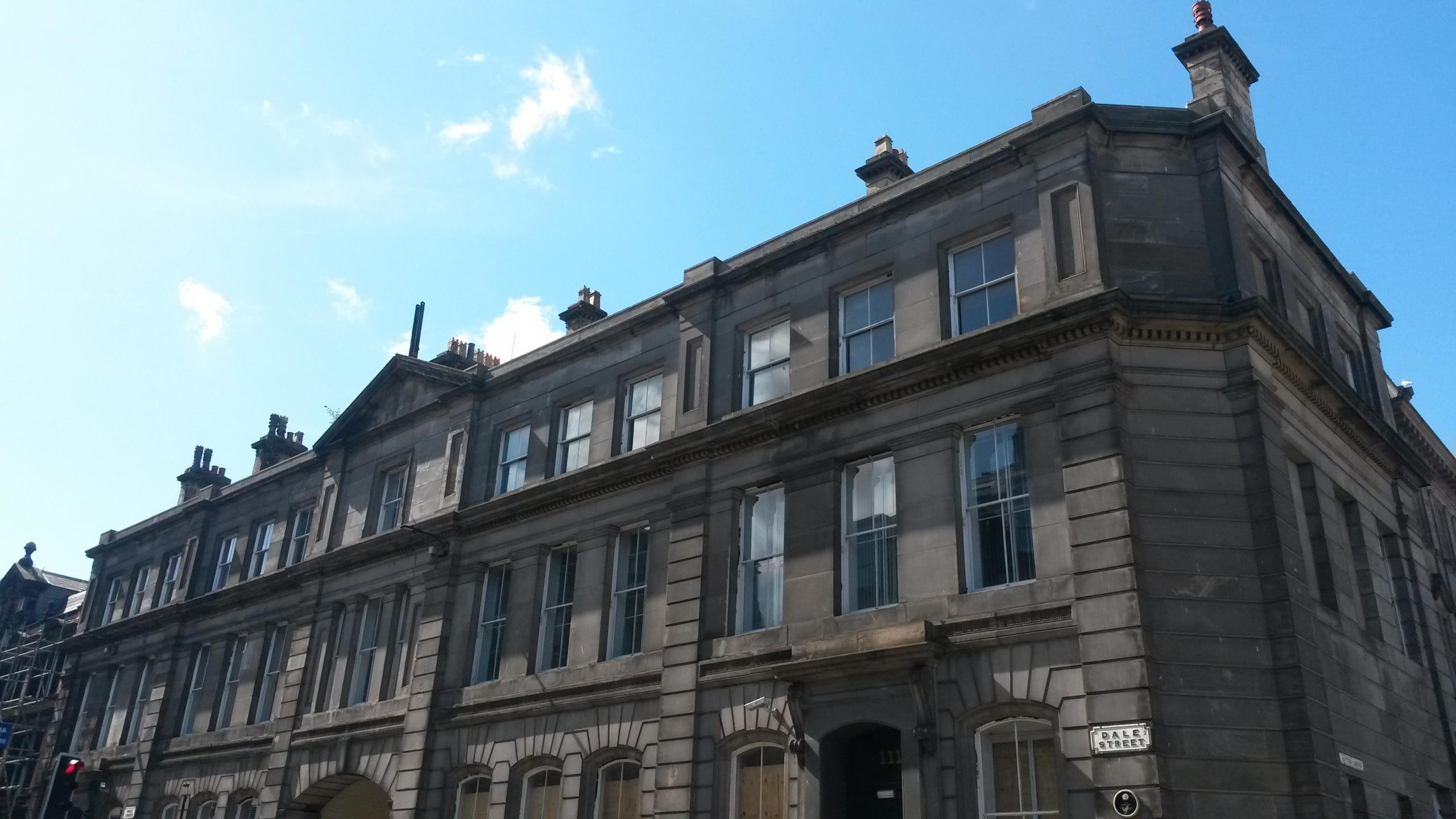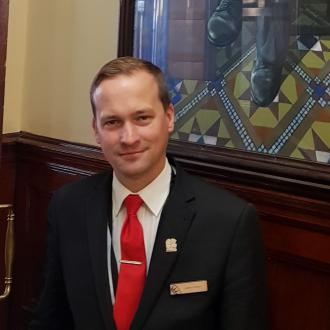In our latest blog, James O’Keeffe, who is one of our official City Halls Tour Guides, delves into the past of the first ever British-born black mayor of anywhere in the UK, John Richard Archer. He also looks to the future of Liverpool’s first ever black Lord Mayor, Cllr Anna Rothery…
Here I am with the portrait of John Richard Archer (1863-1932) in Liverpool Town Hall.
When I give the tour of the Town Hall, I always draw the visitors’ attention to this painting because John Archer was a true political pioneer in this country.
Born in Liverpool at the bottom of Mount Pleasant in Blake Street on 8 June 1863, John Archer became the first British-born black mayor of anywhere in the UK when he became Mayor of Battersea in 1913.
After travelling widely around the world in the merchant navy, during which time he met his wife, Bertha, in Canada, Archer settled in Battersea in the 1890s.
In the early 1900s, he began studying medicine before, finally in 1906, becoming a prizewinning professional photographer opening his own studio and shop in Battersea. 1906 was also the year John Archer stood in the local elections for Battersea.
He was involved in politics having become a member of the African Association (formed in 1897 by black students across the globe) and had attended the first Pan-African conference at Westminster Town Hall in 1900.
In 1906, John Archer stood for election to Battersea Borough Council as a Progressive candidate. He topped the poll with 1,051 votes. Archer shortly afterwards joined the Labour Party and was appointed to the Baths Committee of the council, and subsequently became its Chair.
John Richard Archer, pictured in 1914.
Continuing his political work, Archer was nominated as a candidate for Mayor of Battersea in 1913. The press attention that followed focused largely on his origins with even some newspapers declaring surprise that he had such a command of the English language! He faced a great deal of prejudice and racism during his campaign to become Mayor, including reporters questioning his British citizenship and one newspaper going as far as to state: “It does not meet that the white man should be governed and controlled by a man of colour. It has always been that the white man ruled and it must always be so. If not, goodbye to the prestige of Great Britain”.
Despite this hostility, Archer was victorious being elected as Mayor on 10 November 1913. In his victory speech, Archer declared that his success was a great step forward for racial equality:
“My election tonight means a new era. You have made history tonight. For the first time in the history of the English nation a man of colour has been elected as mayor of an English borough. That will go forth to the coloured nations of the world and they will look to Battersea and say Battersea has done many things in the past, but the greatest thing it has done has been to show that it has no racial prejudice and that it recognises a man for the work he has done”.
Furthermore, in response to some of the racism that he faced during his campaign, John Archer told thecrowd:
“It is a great victory such as never gained before… I am the proud victor. I am a man of colour. Many of the things that have been said about me, however, are absolutely untrue. I have a brother, but I should have to have several for us to be born in as many places as we have been said to have been born in… I am the son of a man born in the West Indian Islands. I was born in England, in a little obscure village never heard of until now – the City of Liverpool. I am Lancastrian born and bred.”
I always think that’s a great response to the prejudice that Archer faced!
Unfortunately, the racism that he experienced before his mayoralty did not disappear and he informed a meeting at Battersea’s Town Hall a month after his election that, since becoming mayor, he had received messages in the post “calling my mother some of the foulest names that it is possible for a mother to be called… I have been made to feel my position more than any man who has ever occupied this chair, not because I am a member of the Council, but because I am a man of colour… Am I not a man, the same as any man? I may be wrong when I come here and meet this opposition, but would not any other man in my position think the opposition was because of his colour?’ Despite this, he continued to feel a personal sense of pride in his role as a pioneer in the field of politics: ‘It filled my heart with joy to walk in the procession of mayors in that old historic building – the first time that one of our race has done so as mayor.”
The council chamber of Battersea was an often stormy place to be and through the years as an elected representative, Archer experienced a number of physical threats and was even assaulted in 1923 when he was dragged out of the chamber, with his fellow Labour councillors, by his head and heels!
He became the first president of the African Progress Union (APU), formed in 1918, to campaign for black political rights and continued to serve on Battersea Borough Council until 1932, the year of his death.
John Archer’s link to Liverpool continued throughout his life and he remained actively interested in race relations in the city of his birth.
In 1919, Liverpool experienced its first race riot which broke out after months of increasing hostility towards Liverpool’s black community against the backdrop of the post-First World War economic slump that had gripped the city. The black population (citizens of the British Empire, many of whom were long-settled in Liverpool) were being blamed locally for pressure on jobs. White workers refused to work alongside black workers and a “colour bar” was introduced in the city. The black population faced destitution due to unemployment but the Lord Mayor, John Richie, sided with white ex-servicemen who continued to complain of the presence of black people.
Incredibly, and perhaps highlighting the violence was more about attacking black people than a more general xenophobia, the incident that changed individual violence to full-blown riot involved Scandinavian sailors who attacked black seamen in a the Liverpool Arms pub on the corner of Bailey Street on Thursday 5 June. Outside the pub at closing time, a fight involving knives and razors developed and four police officers were injured, including two who were shot by the same bullet. A large black gang then ransacked the Scandinavian Home in Great George Square and rioted in the streets.
Upper Pitt Street, Liverpool.
After the crowds dispersed, it seemed at first that the disorder had ended but the police then received orders to raid black seamen’s lodgings. On Upper Pitt Street, a large group of people crowded around a boarding-house that was raided by the police. A 24 year old Bermudan who had served as a fireman in the Royal Navy, Charles Wotten, came out of the house to face the crowd but was subsequently chased through the streets to Queen’s Dock. At the dockside he was apprehended by the police, but he was “wrenched” from their protection by the crowd and either fell or was pushed into the water. The crowd shouted, “Let him drown” and then pelted him with stones and after one hit him on the head, he sank into the water and drowned. No investigation into Wotten’s death was ever carried out and nobody was ever arrested for it. After a long campaign, a memorial was finally erected next to the Queen’s Dock in 2017.
The Charles Wotten memorial, Queen’s Dock, Liverpool.
Over the next week, Liverpool witnessed scenes of rioting and disorder caused by gangs of white youths, sailors and ex-servicemen and supported by large crowds of up to 10,000 attacking black people, as well as businesses and houses. By Wednesday 11 June, because of the escalating violence, more than 700 black people were taken into protective custody by the police at the Main Bridewell of Liverpool.
The Main Bridewell, Liverpool, as it is today.
Archer led a deputation to Liverpool on behalf of the APU to discuss race relations in the city. Initially the blame for the riots was laid at the door of the black population and special Courts were held from June to October 1919 to deal with arrested rioters. Archer offered financial for the services of a barrister, Edward Theophilus Nelson, who defended the black people who had been arrested during the riots. The stipendiary magistrate Stuart Deacon – facing the white men and women who had been arrested for participating in the riots and looting – stated very clearly who he believed was at fault, telling them that they were the ones who were “making the name of Liverpool an abomination and disgrace to the rest of the country”.
The Magistrates Court, Liverpool.
14 black men, though, were sent to the Assizes in St George’s Hall in November, defended by Nelson. Of those fourteen who stood trial, four were acquitted and the other ten were given sentences between eight and 22 months.
When Archer died in 1932, his body was laid to rest in Battersea and he left as his legacy a life of working to improve the lives of those in need. His name is well-remembered in Battersea through Archer House, which was built during the 1930s within the Battersea Village estate and, more recently, High View Primary School Battersea was renamed to Ark John Archer Academy in March 2018.
The English Heritage blue plaque scheme introduced a plaque at his former home (55 Brynmaer Road, Battersea) in 2013, the same year that he was commemorated on a Royal Mail postage stamp as part of a special Great Britons series.
Here in the city of his birth, Archer is remembered in the name of John Archer Hall in Upper Hill Street and through this painting.
The portrait, displayed on the corridor which leads to the Council Chamber, was painted by local artist Paul Clarkson and unveiled at the building in 1999. It includes a copy of The Crisisthe official journal of the National Association for the Advancement of Colored People. The journal reported on Archer’s success in January 1914 which must have been a source of inspiration for Civil Rights campaigners.
Cllr Anna Rothery has been Liverpool’s Lord Mayor since 2019 and will serve a historic second successive term until May 2021.
It is, perhaps, fitting that in the centenary year of that dark page in Liverpool history, that we welcomed to the city Liverpool’s first black Lord Mayor, Councillor Anna Rothery. Cllr Rothery became only the third ever black councillor on Liverpool City Council in 2006, representing the Princes Park ward. She is currently the mayoral lead for equality and race and is a pioneer in her own right, working to bring people together across community, political and religious lines nationally and internationally to deal with issues relating to inclusion and diversity. Just like John Archer, Councillor Rothery is a pioneer in politics; in 2012 she became the first member of Liverpool City Council to address the floor of the United Nations in Geneva, focusing on work to encourage political participation of minority communities in Liverpool. With the recent announcement that she will serve a second year in office as Lord Mayor, Rothery is breaking new ground again, as she is actually the first person to serve two consecutive years in that role since the Second World War. In fact, she joins a list of only three people who have ever served as Lord Mayor of Liverpool for more than a year (the other two being Sydney Jones: 1938-1942 and Sir Frederick Bowring: 1925-27).
It was thanks to the current Lord Mayor, also, that the portrait of John Archer hangs in this prominent position in the Town Hall: she brought it out of storage in 2006. The Lord Mayor has said that John Archer is an inspiration to her and, just as Archer inspired others through his words and actions throughout his life, she too, as Lord Mayor of Liverpool, hopes to continue her status as a positive role model.
ABOUT JAMES O’KEEFFE
James works as one of the official guides of Liverpool’s City Halls. He has worked in his role for 12 years and delivers a wide range of tours in St George’s Hall and Liverpool Town Hall, including the monthly guided tours, St George’s Hall Film tours, Footman tours and the special ‘Walk the Floor’ tours during the Minton Floor Reveal.
He also helps to animate events in the buildings including the traditional Toasting of the Haggis at the Burns Night Ceilidh and Dickens Readings in St George’s Hall’s Concert Room.
With a Master’s Degree in History, James’s passion is British history with a particular interest in all things Liverpool.
